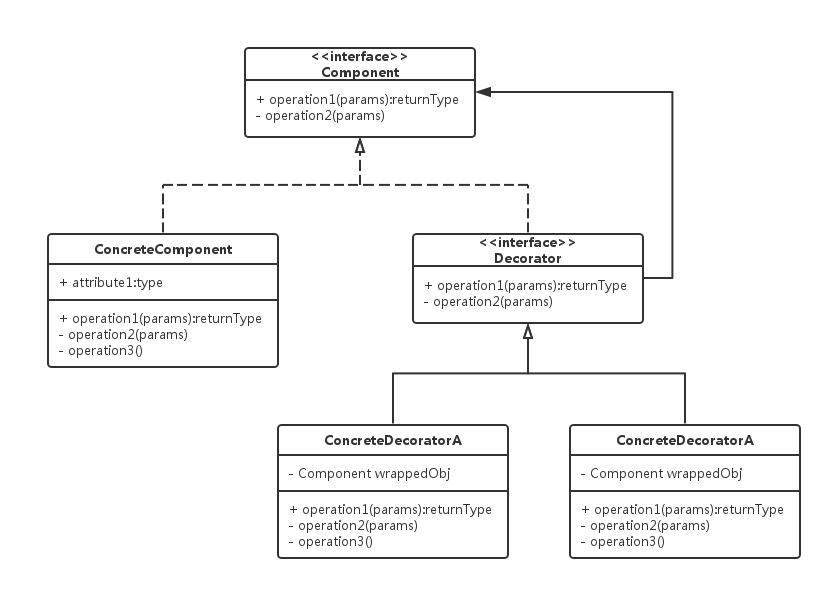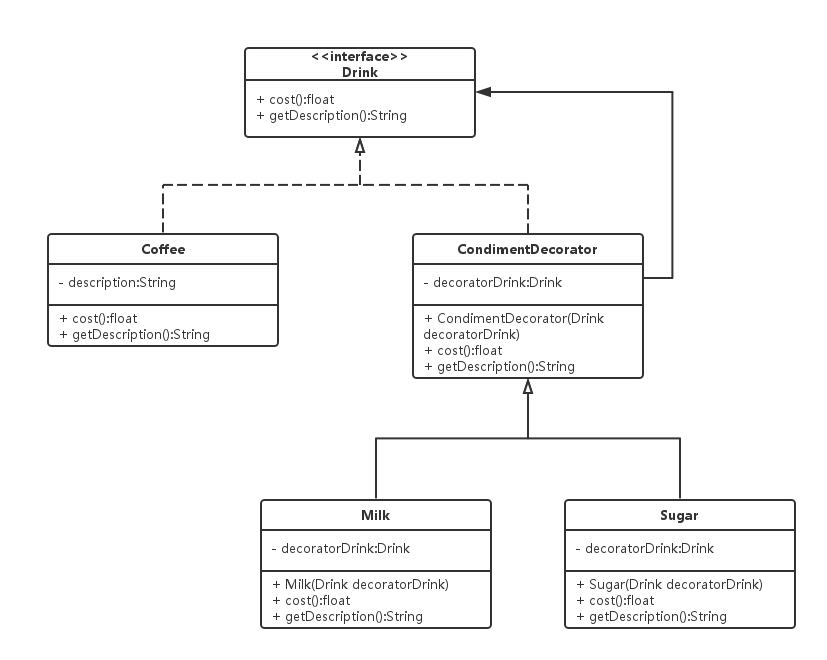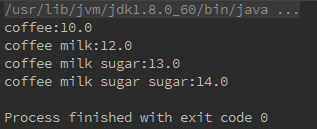设计模式 —— 装饰器模式(Decorator Pattern)
Posted 沈博先生之逍遥游
tags:
篇首语:本文由小常识网(cha138.com)小编为大家整理,主要介绍了设计模式 —— 装饰器模式(Decorator Pattern)相关的知识,希望对你有一定的参考价值。
装饰器模式(Decorator Pattern)
概念
装饰器模式 允许向一个现有的对象添加新的功能,同时又不改变其结构。装饰者可以在所委托被装饰者的行为之前或之后加上自己的行为,以达到特定的目的。
组成
装饰器模式由组件和装饰者组成。
抽象组件(Component):需要装饰的抽象对象。
具体组件(ConcreteComponent):是我们需要装饰的对象
抽象装饰类(Decorator):内含指向抽象组件的引用及装饰者共有的方法。
具体装饰类(ConcreteDecorator):被装饰的对象。
例子:
假设我们现在去咖啡店要了一杯咖啡,可以加奶、加糖等等。咖啡和奶、糖分别有不同的价格。
咖啡就是我们的组件,奶和糖是我们的装饰者,现在我们要计算调制这样一杯咖啡花费多少。
Drink 接口类:
package DesignPattern.Strategy.Decorator;
public interface Drink {
public float cost();
public String getDescription();
}Coffee 类:
package DesignPattern.Strategy.Decorator;
public class Coffee implements Drink {
final private String description = "coffee";
//每杯 coffee 售价 10 元
public float cost() {
return 10;
}
public String getDescription() {
return description;
}
}CondimentDecorator 调味抽象类:
package DesignPattern.Strategy.Decorator;
public abstract class CondimentDecorator implements Drink {
protected Drink decoratorDrink;
public CondimentDecorator(Drink decoratorDrink) {
this.decoratorDrink = decoratorDrink;
}
public float cost() {
return decoratorDrink.cost();
}
public String getDescription() {
return decoratorDrink.getDescription();
}
}Milk 牛奶装饰类:
package DesignPattern.Strategy.Decorator;
public class Milk extends CondimentDecorator {
public Milk(Drink decoratorDrink) {
super(decoratorDrink);
}
@Override
public float cost() {
return super.cost() + 2;
}
@Override
public String getDescription() {
return super.getDescription() + " milk";
}
}Sugar 装饰类:
package DesignPattern.Strategy.Decorator;
public class Sugar extends CondimentDecorator {
public Sugar(Drink decoratorDrink) {
super(decoratorDrink);
}
@Override
public float cost() {
return super.cost() + 1;
}
@Override
public String getDescription() {
return super.getDescription() + " sugar";
}
}测试代码:
package DesignPattern.Strategy.Decorator;
public class CoffeeShop {
public static void main(String[] args) {
//点一杯coffee
Drink drink = new Coffee();
System.out.println(drink.getDescription() + ":" + drink.cost());
//加一份奶
drink = new Milk(drink);
System.out.println(drink.getDescription() + ":" + drink.cost());
//加一份糖
drink = new Sugar(drink);
System.out.println(drink.getDescription() + ":" + drink.cost());
//再加一份糖
drink = new Sugar(drink);
System.out.println(drink.getDescription() + ":" + drink.cost());
}
}上图我们可以看出 coffee 加不同的调味料价格的不同。
适用场景:
- 扩展一个类的功能。
- 动态增加功能,动态撤销。
优缺点:
优点:
- 装饰类和被装饰类可以独立发展,不会相互耦合
- 动态的将责任附加到对象身上。
缺点:
- 多层装饰比较复杂。
参考:
Head First 设计模式
以上是关于设计模式 —— 装饰器模式(Decorator Pattern)的主要内容,如果未能解决你的问题,请参考以下文章


